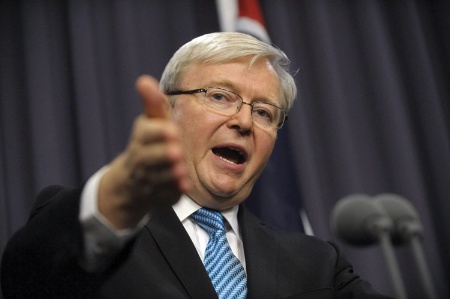Source: Alamy
On a pedestal: graduates may feel on top of the world, but those in higher education in Australia are feeling neglected by politicians and worry that they could be in line for more cuts
The proportion of young Australians with a degree may be heading towards 40 per cent, but few observers expect the future of higher education to be a major issue in the country’s forthcoming general election.
The country’s Labor prime minister, Kevin Rudd, has called the election for 7 September, having dramatically reduced the opinion poll lead of the opposition Coalition since he unseated Julia Gillard in June.
Rudd’s palace revolution also brought back to the Cabinet Kim Carr, who resumed his old science portfolio and was also put in charge of higher education. The government had been under heavy fire from universities incensed by an A$2.3 billion (£1.6 billion) budget cut announced in April to pay for school reforms.
Within hours of his return, Carr said that he was open to budget-neutral alternatives to the cuts, cuts that include a two-year “efficiency dividend” on universities and the abolition of discounts for the upfront payment of tuition fees.
He also hinted that he might be prepared to reimpose the numbers cap on undergraduate recruitment that the Labor government removed in 2012. That decision came after the government accepted the case for increasing to 40 per cent the proportion of Australians between 25 and 34 earning a degree (the current figure is just under 37 per cent).
Carr cited concerns about declining quality in his comments about the removal of the numbers cap. Such concerns are shared by a significant proportion of vice-chancellors, especially those in the elite Group of Eight, which has openly expressed the hope that reimposing the numbers cap would result in the scrapping of the efficiency dividend.
However, both Carr and Rudd continue to proclaim the value of the extra 190,000 students that the demand-driven system has allowed to attend university, and many observers believe that Carr’s apparent open-mindedness is just a ruse to divert universities’ fire.
Gavin Moodie, principal policy adviser at RMIT University, says Carr had stoked up a “faux debate by reviving the false dichotomy between access and quality”.
“Soon universities were debating amongst themselves whether funding should be allocated to increasing research grants or students’ access,” he said. “Problem fixed.”
Growing budget deficit
Andrew Hughes, a lecturer at the Australian National University who researches political marketing, does not see how the demand-driven system could be abolished. Increased admissions were helping all universities to replace revenue lost from the efficiency dividend and the fall in the number of international postgraduate students brought about by toughened immigration policy and a strong Australian dollar, he says.
This way of maintaining university income was particularly significant given Australia’s growing budget deficit, he adds.
The opposition Coalition’s education spokesman, Christopher Pyne, has denied having any plans to reimpose a numbers cap, but few believe that this amounts to a commitment not to do so – not least because he has also said that industry’s concerns about declining quality need to be addressed.
Nor has the Coalition promised to restore the lost A$2.3 billion. Indeed, many in the sector fear that it would be in line for more cuts if there is a change of government on 7 September. Coalition leader Tony Abbott has made great play of ending Labor’s alleged profligacy and has promised to balance the books, while also cutting taxes on carbon emissions and mining and increasing parental leave entitlements.
“This can be achieved only by big cuts to government spending, and higher education is a prime target,” Moodie says.

He makes this prediction despite the Coalition’s pledge to protect the budget of the National Health and Medical Research Council and to streamline its application system. Abbott was health minister in the previous Coalition government under John Howard, and, according to Hughes, he sees medical research as voter-friendly, a large potential future income generator for Australia and a reinforcement of his “brand” of “being supportive of new ideas, innovation and creativity”. But the habit of rubbishing climate science – not to mention medieval history – displayed by opposition politicians does not bode well for research spending more generally, Moodie says.
As for higher education as a whole, he adds, “the Coalition’s higher education shadow, Brett Mason, says his biggest challenge is not persuading his colleagues to adopt a particular policy on higher education but rather to persuade them that higher education is sufficiently important to have any higher education policy at all”. In Moodie’s view, this suggests that the Coalition is “unlikely to devote much attention to higher education in its first term – beyond cutting it”.
Apart from reimposing the numbers cap – at least on publicly subsidised students – the other obvious area Moodie thought the Coalition might cut would be funding per student place, although he envisages universities being allowed to increase tuition fees by a corresponding amount.
Many in the sector fear that higher education is also low on the Labor Party’s political agenda. Carr has not produced any detailed proposals for the sector beyond endorsing a major review of higher education regulation, published in August, which advocated simplifying universities’ complex array of reporting requirements. Carr said he would give the sector more autonomy by exercising oversight, instead, via the Labor-introduced “compacts” – periodically negotiated agreements between individual universities and the government.
Echoing the Coalition’s focus on medical research, Labor has also pledged to co-fund with industry an A$250 million programme aimed at boosting the development of regenerative treatments in areas such as kidney disease.
In the early days of the election campaign, the government postponed a planned cap on tax deductions for individuals’ spending on education. But although Universities Australia had spearheaded a vigorous campaign against the cap, Hughes believes the U-turn had been prompted by Labor’s fear of being punished by “aspirational” voters in key marginal seats.
Nonetheless, he also doubts that many Australians put higher education high on their list of electoral priorities, not least because “most assume we already have good enough universities so there is no need for more money”.
Lack of political clout
The sector’s lack of political clout could be seen in the announcement of the A$2.3 billion cuts just weeks after Universities Australia launched an A$5 million lobbying campaign to highlight the need to invest in higher education, an effort that was itself prompted by last October’s cuts to research and other areas that the umbrella body totalled at A$1 billion.
“The sector needs to be more targeted in its communications about [which party] offers the better option for universities. But this will never happen [because] many vice-chancellors are appointed by governments, so they’d all be a little scared of not getting a job again [if they criticised a particular party],” Hughes says.
However, if vice-chancellors are afraid to be party political, the same cannot be said of Australia’s main academic union, the National Tertiary Education Union. Its national president, Jeannie Rea, openly fears a repeat of the Coalition’s “dreadful past record on cutting back on higher education funding, interfering in university independence and slugging the students with increased fees”.
But the recent cuts were also the “last straw” for the union’s traditional support for Labor, which, in her view, has reneged on a pledge that the demand-driven system would come with increased funding.
Hence, the union has opted to spend A$1 million on an advertising campaign in support of the Greens, who hold the balance of power in the country’s upper house, the Senate.
Rea says the Greens have been “vocal advocates for higher education” and have adopted it as one of their “top priorities” for the election campaign, including endorsing the union’s “reasonable demand” for a 10 per cent increase in funding per domestic undergraduate.
But Hughes dismisses the likely impact of the union’s intervention: “The message will get washed away in the general election spin cycle.”
Register to continue
Why register?
- Registration is free and only takes a moment
- Once registered, you can read 3 articles a month
- Sign up for our newsletter
Subscribe
Or subscribe for unlimited access to:
- Unlimited access to news, views, insights & reviews
- Digital editions
- Digital access to THE’s university and college rankings analysis
Already registered or a current subscriber?




